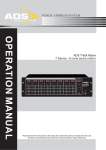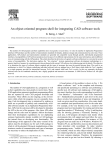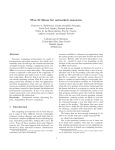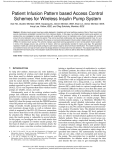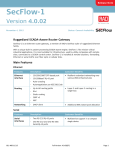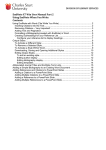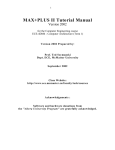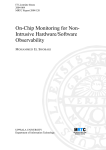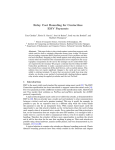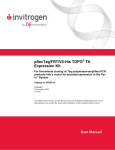Download Enabling Trusted Scheduling in Embedded Systems
Transcript
Enabling Trusted Scheduling in Embedded Systems
Ramya Jayaram Masti† , Claudio Marforio† , Aanjhan Ranganathan† ,
Aurélien Francillon‡ , Srdjan Capkun†
†
†
Institute of Information Security, ETH Zurich, Switzerland
‡
Eurecom, Sophia-Antipolis, France
{rmasti, maclaudi, raanjhan, capkuns}@inf.ethz.ch
‡
[email protected]
ABSTRACT
The growing complexity and increased networking of security and safety-critical systems expose them to the risk of adversarial compromise through remote attacks. These attacks
can result in full system compromise, but often the attacker
gains control only over some system components (e.g., a peripheral) and over some applications running on the system.
We consider the latter scenario and focus on enabling onschedule execution of critical applications that are running
on a partially compromised system — we call this trusted
scheduling. We identify the essential properties needed for
the realization of a trusted scheduling system and we design
an embedded system that achieves these properties. We
show that our system protects not only against misbehaving applications but also against attacks by compromised
peripherals. We evaluate the feasibility and performance of
our system through a prototype implementation based on
the AVR ATmega103 microcontroller.
1.
INTRODUCTION
Today, security- and safety-critical systems are being increasingly networked to facilitate their remote configuration,
control and monitoring. As a result, they face an increased
risk of adversarial compromise and therefore have to be designed to meet their real-time constraints even if they are
partially compromised. More specifically, it is necessary to
architect them such that they can guarantee the execution
of certain critical functionality despite the presence of other
misbehaving system components (e.g., compromised applications, peripherals). We refer to this property of preventing
applications and components under the attacker’s control
from changing the execution times of other applications as
trusted scheduling. Recent examples of compromised embedded systems [10], control systems [16] and peripherals [15]
show that this is an emerging problem.
Most safety-critical systems include a real-time operating
system (RTOS) [5, 6] or similar system management software (e.g., microkernel [18]) whose primary goal is to en-
Permission to make digital or hard copies of all or part of this work for
personal or classroom use is granted without fee provided that copies are
not made or distributed for profit or commercial advantage and that copies
bear this notice and the full citation on the first page. To copy otherwise, to
republish, to post on servers or to redistribute to lists, requires prior specific
permission and/or a fee.
ACSAC ’12 Dec. 3-7, 2012, Orlando, Florida USA
Copyright 2012 ACM 978-1-4503-1312-4/12/12 ...$15.00.
sure that their real-time constraints are met. More recently,
these RTOS also include mechanisms to contain the effects of
other misbehaving software components/applications. However, RTOS do not address threats by untrusted peripherals
(e.g., an RTOS cannot prevent a compromised peripheral
from making the peripheral bus unusable by not adhering
to the bus protocol). Furthermore, their complexity makes
them prone to vulnerabilities that can be exploited to force
the system to deviate from its expected behavior [4].
In this work, we address the problem of enabling trusted
scheduling in the context of security- and safety-critical embedded systems. These are specialized devices that typically
include a CPU, memory and some peripherals connected to
the CPU via the peripheral bus. They usually run a fixed set
of applications whose resource requirements are well-known
in advance. We first identify three essential components of a
trusted scheduling architecture, namely, secure scheduling,
secure resource allocation and application state protection.
This is in contrast to conventional scheduling that only focuses on the CPU allocation.
Second, we describe an embedded system architecture that
achieves trusted scheduling and analyze its security. Our architecture includes five main hardware components, namely,
a scheduler which decides the order in which applications
execute, time-slice and atomicity monitors that ensure CPU
availability, an application-aware memory protection unit
which mediates memory access and a peripheral bus manager which controls access to the peripheral bus. These components, together with a thin layer of software, ensure that
misbehaving applications and peripherals cannot influence
the system’s expectation for other applications. We show
that our architecture provides strong guarantees against remote attacks that exploit software vulnerabilities which we
believe is crucial for today’s safety-critical systems. We
then evaluate the feasibility of realizing such an architecture through a prototype implementation based on the AVR
ATmega103. Finally, we discuss how the design of system
components (e.g., bus, peripherals) can affect the feasibility
of achieving trusted scheduling on a particular architecture.
The rest of the paper is organized as follows. In Section 2
we discuss the problem of enabling trusted scheduling and
identify the functions needed to achieve it in a system. In
Section 3, we describe a trusted scheduling architecture for
embedded systems and analyze its security. In Section 4, we
discuss several practical security issues involved in realizing
a trusted scheduling architecture. We present preliminary
performance considerations in Section 4.2. Finally, we discuss related work in Section 5 and conclude in Section 6.
Sensor
C
RAM
(OS + Applications)
CPU
Memory
Actuator
A
System Bus
CPU
Radio
Peripheral Bus
CPU + Memory
Sensor + Actuator
EEPROM
Radio
.......
Timer(s)
Radio
A delays C
time
Radio delays C
Intended schedule
Figure 1: Most embedded systems consist of a CPU,
memory (for code and data) and a set of peripherals that interact over a system bus and a peripheral
bus. Typically, the peripherals are connected on a
separate bus for efficiency reasons.
Figure 2: The execution schedule of a critical application C can be disrupted by a misbehaving (noncritical) application A that does not release the CPU
on-time or exhausts the memory or by the radio peripheral that does not release the bus on-time.
2.
the presence of compromised applications and peripherals.
Hence, in this work we focus on a broader notion of scheduling in adversarial contexts that we call trusted scheduling
and define below.
We say that a system enforces trusted scheduling if it prevents (possibly colluding) applications and components under
the attacker’s control from changing the execution times of
other applications such that they do not correspond to the
intended schedule. In this work, we primarily focus on attacks that aim to delay or entirely prevent the execution of
applications. We further assume that the applications do
not fully depend on attacker-controlled applications or components for their execution; otherwise, little can be done to
ensure trusted scheduling. Similarly, we also assume that
the data influencing the execution schedule of applications
either directly (e.g., as an input to the scheduler) or indirectly (e.g., persistent system data) cannot be modified by
an attacker.
The problem that we want to solve in this work is that of
designing an embedded system that enforces trusted scheduling, assuming that the attacker controls a subset of applications and system components. Existing real-time systems
include software [6, 5, 18] and hardware [13, 19] to provide
resilience against compromised applications, but do not consider misbehaving system components (peripherals).
TRUSTED SCHEDULING
In this section, we define trusted scheduling and identify
the requirements that a system must satisfy in order to enable trusted scheduling.
2.1
Problem Statement
Trusted scheduling is the property of ensuring adherence
to the intended execution schedule in adversarial settings.
To illustrate the problem of enabling trusted scheduling,
we consider a simple embedded system S (Figure 1) that
consists of a CPU, memory unit(s) and peripherals that are
connected over one or more buses. Most embedded systems
have two such buses: a system bus that is used to connect
main components (e.g., CPU) to the memory unit(s) and a
slower peripheral bus (e.g., SPI [9], I2 C [12]) that is used to
connect the CPU to the peripherals (e.g., EEPROM, realtime clock, radio and other I/O interfaces). The system
hosts a number of applications that are entirely independent
and self-contained.
We consider an attacker M who controls a subset of applications and system components and is interested in interfering with the execution schedule of other (critical) applications that it does not control. For example, M could
compromise an application and use it to gain control over
the network card on the peripheral bus. We assume that
M does not have physical access to the system and hence
cannot launch physical attacks. We further assume that the
attacker cannot influence any external inputs that affect the
system’s execution schedule.
This model corresponds to systems where critical and noncritical applications/peripherals co-exist. For example, a
system can consist of a critical control (sensing/actuating)
application and a non-critical communication application
used for the sole purpose of reporting (Figure 2(a)). In this
example system, if the radio peripheral or status reporting
application is compromised, they could attempt to influence
the execution schedule of the critical control application; this
is illustrated in Figure 2(b). While conventional scheduling
(or CPU scheduling) suffices to guarantee adherence to the
intended schedule as long as all applications and peripherals are benign, it alone cannot provide similar guarantees in
2.2
Realizing Trusted Scheduling
Although systems are diverse and the application scenarios in which they are used largely differ, there are still some
common functionalities that all systems must realize to support trusted scheduling which we discuss below.
To support trusted scheduling, a system should implement
a robust scheduler, protect system resources and protect the
applications. More precisely, the system must be designed
such that the attacker (i) cannot modify the execution schedule of applications (ii) cannot interfere with the allocation
of resources to the applications and (iii) cannot modify the
state of applications (code and data).
This effectively implies that, a trusted scheduling system
should implement a secure scheduler that schedules the execution of applications and enforces adherence to this schedule. Furthermore, this system should securely isolate appli-
Partitioned RAM
Trusted Domain
Application-aware MPU
System Bus
Time-slice Atomicity
Monitor
Monitor
Scheduler
EEPROM
Radio
CPU
Peripheral Bus Manager
Peripheral Bus
Figure 3: Our trusted scheduling architecture uses a thin layer of software (trusted domain) to initialize and
configure its hardware components. The scheduler informs the trusted domain when a new application has to
be executed. The trusted domain saves the current system state and transfers control to the new application.
The CPU time-slice monitor and the atomicity monitor together guarantee that the trusted domain can
regain control of the CPU when needed. Each application is allocated its own dedicated memory partition
and application boundaries are enforced using an application-aware memory protection unit (MPU). Finally,
the peripheral bus manager controls access to peripherals and also prevents misbehaving peripherals from
denying applications access to the bus.
cations such that their code and data are protected, preventing the attacker from modifying applications or preventing
their correct execution by modifying their data. Finally, the
system should be able to securely multiplex shared system
resources and ensure that applications are able to obtain all
resources they need on-time for their correct execution. Ensuring the correct allocation of resources prevents internal
Denial-of-Service (iDoS) attacks in which an attacker holds
on to a system resource (e.g., a bus or a peripheral) required
by another application or exhausts system resources to prevent other applications from running (e.g., dynamically allocating memory until it runs out).
In the next section, we describe our design of an embedded system that follows the above reasoning and supports
trusted scheduling.
3.
TRUSTED SCHEDULING SYSTEM
Our trusted scheduling system is designed for real-time
systems with a pre-defined set of applications. It is tailored for embedded devices that are used in security- and
safety-critical applications that have a well-defined and focused purpose. The system is initialized and configured by
a trusted administrator and is not expected to be modified
by the user during use.
3.1
System Overview
Our system is shown in Figure 3. It includes standard embedded system components (shown in white): CPU, RAM,
system bus, peripheral bus, peripherals and trusted scheduling extensions (shown in gray): trusted domain, scheduler,
application-aware MPU, time-slice and atomicity monitors
and a peripheral bus manager.
The scheduler manages the execution of applications and
informs the trusted domain when a new application must be
executed. The scheduler triggers execution of applications
according to its pre-determined schedule or in response to
external events. The scheduler is therefore configured with
the scheduling policy it must enforce and is aware of the
applications that are running on the system. When a new
application is scheduled to be executed, the trusted domain
saves the current state of the system and transfers control to
the new application. Before the actual execution of the application itself, the trusted domain configures and activates
the desired CPU time-slice monitor (e.g., a timer interrupt)
and the atomicity monitor that transfer control back to it
from the application. The CPU time-slice monitor and the
atomicity monitor together guarantee that the trusted domain can regain (with minimal latency) control of the CPU
when needed. The scheduler is isolated from the applications and other system components; it acts directly on the
CPU and thus can always stop and start the execution of
the applications. In order to ensure application isolation,
each application running on the system is allocated its own
dedicated memory partition and application boundaries are
enforced using an application-aware memory protection unit
(MPU). Finally, to ensure that bus access to the peripherals
is securely mediated, we introduce a peripheral bus manager. This peripheral bus manager controls access to the
peripheral bus from the various peripherals and prevents
misbehaving peripherals from denying the CPU (the running applications) and other benign peripherals access to
the bus. It also ensures that each application can only access the set of peripherals to which it has been granted access
by the trusted domain.
Every application starts executing at its first instruction
and continues until it terminates, violates a security policy
or is preempted. A security exception is raised if an application tries to access or modify code or data that does not
belong to it. A security exception is also raised if an application tries to execute an atomic section that is larger than
the preset limit or if its allocated CPU time-slice expires.
Additionally, the peripheral bus manager also raises a secu-
A1 executes
A2 executes
A3 executes
Trusted domain executes
Run A1
A2 resumes
Time
Run A2
Run A3
A3 starts
Figure 4: The trusted domain must save and restore
state during a context switch to prevent applications
from accessing and/or modifying each others state.
rity exception if any application tries to access a resource
to which it has not been granted access or if the length of
any bus transaction exceeds a pre-determined upper bound.
Alternatively, the upper bound on the length of bus transactions can also be enforced by the atomicity monitor. When
an application is preempted or forcibly terminated due to a
security exception, control is transferred back to the trusted
domain (via the hardware scheduler) which resumes execution of pending applications.
In terms of the system initialization, we assume that a
trusted administrator supplies system initialization values
to the trusted domain. When the system is powered-on,
the trusted domain executes first and performs system initialization based on the inputs provided by the administrator. These inputs may include (but are not limited to) the
number of applications, the peripherals they use, their memory layout, execution schedule, preemption policies (like the
maximum CPU time-slice for each application, etc.). The
trusted domain configures the scheduler for periodic and/or
event-driven execution of applications. Furthermore, it also
configures the resource allocator’s CPU preemption policies
and the application-aware MPU to create dedicated program
and data partitions for each application. Finally, the trusted
domain initializes the program memory of individual applications and configures the peripheral bus manager with information regarding the peripheral access requirements of
the applications.
3.2
System Components
We now describe selected hardware and software components of the trusted computing base (TCB) in more detail.
Trusted Domain
The trusted domain is the only software component of the
TCB and resides in ROM. The trusted domain is responsible for initializing the hardware scheduler, components that
allocate system resources (described below), handling context switches between applications and the actual transfer
of control from the scheduler to the individual applications
(Figure 4). We chose this approach in order to prevent malicious applications from accessing or modifying the state of
their predecessors which could result in a violation of trusted
scheduling. The trusted domain uses a dedicated data partition in RAM that is not accessible by any other application
or system component.
Scheduler
Our architecture includes a hardware-scheduler that uses information about external events and internal logic to decide
the order in which applications execute. Although using a
hardware scheduler limits flexibility (adding, removing applications, changing algorithms, etc.), we believe that this is
an acceptable trade-off for security in real-time systems, as
they are mostly single-purpose and run applications that do
not change frequently (e.g., due to safety compliance issues).
The scheduler transfers control to the trusted domain that
in turn transfers control to the actual application.
Our scheduler implements preemptive scheduling. Although co-operative scheduling, where applications are allowed to
execute to completion or co-operatively release the CPU,
may be simpler and more efficient than preemptive scheduling, relying upon applications to release the CPU punctually
can be dangerous in adversarial settings. This is because
malicious applications may hold onto the CPU and hence
delay (or in the worst case prevent) the execution of other
applications. Hence, in order to achieve trusted scheduling,
one must use preemptive scheduling schemes where the execution of any application can be interrupted at any point
of execution except for those that the application explicitly
labels as atomic.
Resource Allocation Components
The resource allocator must ensure that applications have
access to at least three system resources while executing:
CPU, memory and the bus(es).
CPU Availability
Atomic sections are required to ensure the correctness of certain operations (e.g., updating the stack pointer (SP )). The
sequence of instructions in an atomic section ((i) decrementing the existing SP value and (ii) re-storing the new value
in SP ) should be executed without interruption. Otherwise,
a corrupt system state (SP ) may result. Hence, if an application is executing an atomic operation, the scheduler would
have to wait until it completes the operation before suspending it. Although it is recommended that atomic operations
should be as short as possible, a malicious application could
declare large portions of code as atomic and hence delay, or
in the worst case prevent the execution of another application. In order to prevent such attacks, the system must be
able to bound the maximum duration (in time) of atomic
operations.
Our architecture (Figure 3) includes an atomicity monitor
that tracks the length of atomic code sections. The atomicity monitor terminates an erring application which exceeds
a pre-defined execution upper bound. This requires that all
applications are designed to respect this bound; otherwise
they will fail to execute correctly. We note that this bound
does not apply to the trusted domain. The atomicity monitor must also prevent nesting of atomic sections to increase
their effective length. Furthermore, the trusted domain configures an additional CPU time-slice monitor (e.g., a timer)
just before it transfers control to the individual application.
Memory Availability
Applications typically need two types of memory: program
memory for their code and data memory for their stack and
heap.
The use of shared stacks and heaps allows compromised
applications to launch iDoS attacks by potentially exhausting stack or heap space. Recovery from such stack and heap
overflow attacks requires invalidating current stack frames
(e.g., by unwinding) and heap data. Although solutions that
guarantee such secure stack sharing exist [24, 20], recovering
from security violations can be complicated and expensive.
This is because identifying and invalidating data memory
regions that caused the violation can be both costly and
time-consuming. For example, upon a security exception,
one may have to unwind multiple stack frames which is time
consuming compared to simply swapping the stack pointer.
Enforcing access control policies in systems with shared data
memory can also be complicated because it requires maintaining ownership information on individual stack frames
and heap blocks as described in [20]. Therefore, we use
dedicated data partitions for each application and depend
upon the application-aware MPU (described below) to prevent iDoS attacks on data memory. A similar approach is
used to ensure availability of program memory. Although
such partitioned memory architectures limit flexibility, we
believe they are still suitable for use in trusted scheduling
architectures for such specialized systems whose memory requirements are typically known in advance.
In practice, most embedded systems use a memory protection unit (MPU) or a memory management unit (MMU)
for protecting each application’s state against unauthorized
access or modification. Typically, such a unit only enforces
access control policies (read, write, execute) at run-time on
segments or pages of memory, and the operating system is
responsible for separating memory regions of different applications. Our trusted scheduling architecture relies on a
specialized MPU that combines these two functions, i.e., an
application-aware MPU that not only checks for the type
of access to memory but also whether the entity initiating
such an access has the appropriate privileges. For specialized
embedded devices with relatively long lifetimes, enhanced
MPUs and MMUs that are application-aware (e.g., ARM [1],
NIOS II [7]) present a reasonable trade-off between flexibility and better security.
In our system, the trusted domain configures the application-aware MPU with information regarding the boundaries of
different applications. Every memory access (both program
and data memory) is then mediated by this MPU.
Mediation of the Bus Access
If an application cannot gain access to the memory or to
the peripherals that it needs for its correct execution, it
will fail to execute. A compromised system component with
access to a bus can cause such failures by holding on to the
bus — preventing any communication among other system
components that are connected to the same bus. We call
this attack an iDoS attack on the bus.
In our system, we do not consider DMA-capable peripherals and assume that all peripherals access memory only
through the CPU. We assume that the atomicity monitor
enforces the upper bound on the length of bus transactions.
This in turn prevents iDoS attacks on the system bus. We
discuss this further in the security analysis (Section 3.3).
In addition to components connected to the system bus,
components on the peripheral bus are also often crucial for
the operation of the system or of individual applications,
e.g., EEPROMs containing system configuration data may
need to be accessed in a timely manner, an alarm application needs to have access to the radio peripheral to transmit
alarm messages. In order to ensure the availability of the
peripheral bus, we propose a secure hardware bus manager
that mediates bus access requests.
In our system, we consider a multi-master (multi-)slave
bus (e.g., I2 C ). In most multi-master bus architectures, a
typical data exchange consists of three phases: bus-arbitration, data-exchange and bus-release. Bus-arbitration is used
to establish a bus-owner when there are several contenders
(or masters). Arbitration is followed by data exchange and
by an explicit bus-release phase in which other bus masters
are informed about the availability of the bus. These three
phases constitute a bus transaction and it is always executed
atomically.
The shared nature of the multi-master bus allows a misbehaving peripheral to affect (by delaying or denying bus
access) the execution of the applications that do not directly
depend upon it. A misbehaving peripheral could deny bus
access in the following ways:
(i) A misbehaving master peripheral may not respect the
rules of bus arbitration and may continue its transmission beyond what it is allowed, thereby indirectly
disrupting or modifying data on the bus.
(ii) A misbehaving master peripheral could gain access to
the bus by sending carefully crafted data to win busarbitration every time and then sending data continuously without releasing the bus.
(iii) A misbehaving slave could delay its master node for
arbitrary lengths of time.
In our system, we prevent these attacks by introducing a
secure peripheral bus manager. This manager is configured
by the trusted domain at start-up with information regarding the list of peripherals that must be accessed by each
application. The manager uses this information at run-time
to ensure that only peripherals that are needed by the executing application have access to the bus.
The manager further allows an application to selectively
enable and disable peripherals at run-time. Such fine-grained
control allows an application to only enable the peripheral
that it is currently using. As a result, a misbehaving peripheral cannot influence any execution sequence during which
it is not enabled and an application’s interaction with any
other peripheral that is not concurrently active. Together,
these two features enable graceful degradation in the functionality of the application while maintaining tight security
guarantees. However, little can be done if the misbehaving
peripheral is critical for the application’s correct execution.
Finally, the manager ensures that if an application terminates as a result of a security violation, then all the devices
(peripherals) to which it had access are reset before they
are re-used. We present a realization of a peripheral bus
manager for the I2 C bus in Section 4.
3.3
Security Analysis
In this section, we analyze the security of our system. As
described in Section 2, our attacker does not have physical
access to the system, but can only remotely compromise
selected applications and system components.
We assume that our trusted scheduling extensions (scheduler, trusted domain, application-aware MPU, peripheral
PROM
Trusted Domain
Application 1
Application 2
...
...
SRAM
Trusted Domain
Application 1
Application 2
...
...
Event Interrupts
AVR Core
Timer
(Time-Slice
Monitor)
CLIX Instr.
(Atomicity
Monitor)
Application
Aware
MPU
Application
Tracker
Currently, each slave is a simple register
file which is a commonly used device
interface.
I2C
Slave 2
I2C
Slave 1
Peripheral
Bus manager
I2C Bus
Figure 5: Our prototype implementation consists of a modified AVR core, partitioned data and program
memories and a peripheral I2 C bus manager. The trusted domain also resides in its own dedicated RAM
partition which other applications cannot access. The time-slice monitor is implemented using one of the
AVR’s timers and the atomicity-monitor is implemented as a custom instruction (clix). The applicationaware MPU enforces memory boundaries of applications using information from the application tracker. The
peripheral I2 C bus manager mediates access to the I2 C bus according to its access control map.
bus manager, time-slice/atomicity monitors) are implemented correctly and were initialized properly in a trusted initialization step that is free from adversarial interference.
Furthermore, all of these components have simple logic, which reduces the risk of vulnerabilities in their implementation. We assume that the attacker cannot control inputs
to the scheduler either directly (as external input) or indirectly (through applications that it controls). Allowing only
the trusted domain to access the trusted scheduling components eliminates the risk of compromise of these secure
elements by other applications. We assume that any system update (applications or configuration) involves a similar
trusted initialization step and is adversary-free.
We analyze our system assuming that the attacker controls (up to) all of the applications on the system, except
the critical application and (up to) all of the peripherals except the ones needed by the critical application. We show
that even in this scenario, the execution schedule of the critical application will not be affected by the attacker. We
further show that even if the attacker controls a subset of
the peripherals that are used by the critical application, our
system still ensures that the application executes on time,
albeit with a reduced or compromised functionality due to
the compromise of the peripheral.
Compromised Applications
The CPU time-slice monitor and the atomicity monitor ensure that misbehaving applications cannot indefinitely deny
CPU access to other applications — no application can occupy the CPU longer than its assigned duration or execute
bus transactions/atomic operations longer than a predefined
length. This prevents iDoS attacks on the system bus by
misbehaving applications since they can occupy the CPU
(which is the only master of the system bus) only for a limited amount of time. Since an application can use a peripheral only as long as it has CPU-context, the time-slice
monitor also prevents iDoS attacks against peripherals from
misbehaving applications.
The application-aware MPU isolates applications such that
they are restricted to using only their own code and data
memory. This ensures that they do not occupy more than
their share of memory space or interfere with other applications. Furthermore, the application-aware MPU and the
trusted domain mediate context switches and prevent unauthorized cross-application state access and modifications.
The above countermeasures prevent one or more misbehaving applications from delaying or preventing the execution of the critical application.
Compromised Peripherals
Our system enforces that all peripherals can access memory only through the CPU (no DMA) and hence through
the application-aware MPU; given this, there is no threat of
iDoS attacks by peripherals on the system bus. However,
a peripheral can attempt to disrupt trusted scheduling by
launching iDoS attacks against the peripheral bus. This attack is prevented by the use of the peripheral bus manager
that fully mediates the access of peripherals to the bus. The
peripheral bus manager ensures that only the peripherals
required by the currently executing application are active.
This prevents other compromised peripherals from interfering with the execution of an application.
Furthermore, the system prevents peripherals from executing a long bus transaction — the length of any bus transaction (which is an atomic operation) is bounded by the
atomicity monitor. Hence, misbehaving peripherals alone
cannot disrupt trusted scheduling or the communication between the critical application and its peripherals.
Finally, even in the case of misbehaving applications and
peripherals that are under the control of the same attacker,
the combination of the above mechanisms ensures that the
execution schedule of the critical application is not modified
provided it does not depend on the misbehaving peripherals.
4.
IMPLEMENTATION AND EVALUATION
In order to demonstrate the feasibility of realizing a trusted
scheduling architecture, we implemented a prototype embedded system based on the AVR ATmega103 core. Our
prototype (Figure 5) is a simplified instance of the architecture shown in Figure 3. It consists of a modified AVR core
CLK
(a) clix instruction execution
INS
clix3
inst1
inst2
inst3
inst4
. . . inst1−4 6= clix / cli / sei
clix3
clix3
clix3
inst1
inst2
. . . inst1,2 6= clix / cli / sei
clix3
inst1
inst2
inst3
clix3
. . . inst1−3 6= clix / cli / sei
INTR EN
(b) Nested clix
instructions
INS
INTR EN
(c) Pending interrupts vs. clix
INS
INTR EN
Process pending interrupts
before this clix
Figure 6: In order to limit the number of cycles for which interrupts can be disabled by untrusted applications,
we introduce a new processor instruction (clix) which can be used to bound the maximum duration for which
interrupts are disabled. We also implemented additional safeguards to prevent an application from disabling
interrupts for a longer period by executing clix continuously or at regular intervals.
that is connected to two slave devices (register files) on an
I2 C bus. We chose the AVR ATmega core and the I2 C bus
due to their widespread use in embedded systems. In what
follows, we describe our implementation in detail and then
present initial results on the performance of our prototype.
4.1
Our Prototype
In our prototype, the trusted domain, which manages the
scheduler, time-slice and atomicity monitors, applicationaware MPU and the peripheral bus manager, is hosted in
its own dedicated portion of RAM (instead of ROM) which
is not accessible by other applications. The trusted domain also has exclusive access to a set of registers that
hold security-critical information. This was necessary to
ensure that misbehaving applications do not access or modify security-critical system parameters, e.g., the maximum
length of an atomic section that is stored in a register and
initialized during system start-up by the trusted domain.
We added secure registers to store information regarding the
currently executing application (in the application tracker),
the trusted domain’s stack pointer and the boundaries of
different applications. We also modified the interrupt mask
register (that is used to determine the set of active interrupts and hence, the set of applications that may interrupt
the current application) and the timer corresponding to the
time-slice monitor to be secure registers.
The scheduler is implemented using the set of prioritized
interrupts available in the AVR core. It supports prioritybased scheduling of applications with fixed and unique priorities. The highest priority interrupt line is reserved for
the trusted domain and applications are executed as interrupt handlers. A high priority panic interrupt is fired when
a security violation (as detected by the application-aware
MPU, time-slice monitor, atomicity monitor or peripheral
bus manager) occurs. It is important that the security panic
interrupt is non-maskable, i.e., it can never be disabled.
CPU preemption occurs automatically based on the priority
of an incoming interrupt. The CPU time-slice monitor is
implemented as a hardware timer that fires a security inter-
rupt when it expires. The atomicity monitor is implemented
as a custom instruction.
Furthermore, since the original AVR does not have an exclusive MMU or MPU module, we extend the core with a
custom MPU that is initialized by the trusted domain. During system start-up the trusted domain loads the memory
map of applications into the MPU. Then the MPU enforces
application boundaries in program and data memory using
the information about currently executing application that
it obtains from the application tracker.
Memory partitions that are enforced by the MPU are created at compile time, i.e., by compiling the trusted domain
and applications into a custom executable. The executable
contains information regarding the load addresses of applications in RAM and their data regions (stack, heap and globals) and hence facilitates mapping of applications to separate
(program and data) partitions. The trusted domain multiplexes the stack pointer between different applications. We
extended the AVR core with an additional stack pointer that
is used exclusively by the trusted domain. The trusted domain is also responsible for saving and restoring application
contexts. We store the context of an interrupted application on the trusted domain’s stack, which is accessible only
by the trusted domain. This prevents any malicious application from accessing and modifying the state of any other
application.
Atomicity Monitor
Since our prototype uses interrupt-based preemption mechanisms, applications disable all interrupts before executing
atomic operations. In order to limit the maximum length of
atomic operations, we added a custom instruction clix Y to
the AVR core that disables all interrupts for Y cycles (Figure 6). We extended gcc (version 4.3.2) and binutils (version 2.20.1) to enable support for this new instruction. The
value of Y is fixed at compile-time based on the atomic section’s declared length. The generated application binaries
use the custom instruction clix in place of the conventional
cli instruction and a security exception is raised if any ap-
plication (other than the trusted domain) executes the cli
instruction.
It is important to derive a practical bound on the maximum duration for which interrupts can remain deactivated
by an untrusted application using clix. We refer to this
upper bound as max_clix: the largest argument (maximum
value for Y) that can be processed by a single clix instruction. This value is held in a dedicated register initialized
by and accessible only to the trusted domain. Furthermore,
enforcing the upper bound using clix requires the following
additional safeguards:
(i) No application other than the trusted domain is allowed to execute the cli instruction.
(ii) Misbehaving applications may try to nest the execution of critical sections, i.e., they may execute the clix
instruction consecutively and hence increase the effective number of cycles for which interrupts remain disabled (Figure 6). We prevent this in our prototype by
ignoring clix instructions that occur while an older
clix is being processed.
(iii) Pending interrupts should always be processed in precedence to clix instructions (Figure 6). This is important in the case when an interrupt occurs between a
clix a and clix b instruction that are exactly a cycles apart. It must also be ensured that the clix b
instruction is processed once the interrupt handler has
completed.
Peripheral I2 C Bus Manager
Our prototype includes a peripheral bus manager (Figure 7)
that controls access to an I2 C bus that connects the CPU
to peripherals. The I2 C bus is a two-wire serial bus. One
of the wires is used for data and the other for control or
clock signals. In practice, peripherals are connected to the
bus using tri-state buffers (one each for the data and clock
lines). Each peripheral typically controls its own tri-state
buffer.
In our prototype (Figure 7), the access control map of the
peripheral bus manager is initialized by the trusted domain
with information regarding the set of peripherals that each
application is allowed to access. Additionally, each application can choose to enable only a subset of all the peripherals
to which it has been granted access using the peripheral selection register (PSR). The bus manager restricts access to
the bus by controlling the enable signal of the tri-state buffer
that connects the peripheral to the bus, i.e., the peripheral
can access the bus only when the enable signal from the bus
manager is also low. Finally, on the occurrence of a security
violation (panic is high), the bus manager resets all the currently active devices so that they are ready for use by the
next application that executes.
4.2
Preliminary Evaluation
In this section, we present an initial evaluation of our prototype with respect to its timing properties and hardware
resource utilization.
Application Activation Latency
We evaluate the timing properties of our prototype in terms
of its activation latency. Activation latency refers to the
time elapsed between the arrival of a request for application
Figure 7: The secure I2 C bus manager (shown in
gray above) restricts access to the bus by controlling
tri-state buffers that are used to connect peripherals
to the I2 C bus. The trusted domain initializes the
peripheral access control map with information regarding the peripherals which each application can
access. Each application can in turn enable a subset of these peripherals using the Peripheral Select
Register (PSR).
execution and the actual execution of the application. When
the system is idle, the activation latency is equal to the context switch time and we call this the ideal activation delay.
In our prototype, this includes time required to save the current program counter, all the general purpose registers (32
registers in the case of the AVR ATmega103), the current
stack pointer, timer register representing the remaining execution time, peripheral selection register and the interrupt
mask register. This takes about 114 CPU cycles ('9.1 µs
when the processor runs at 12.5 MHz) and is our system’s
ideal activation time.
In the non-idle state of the system, the activation latency
depends on whether execution control rests within another
application or a context switch. If execution control rests
within an atomic section of a lower-priority application, then
the activation delay increases by the number of remaining
cycles in the atomic section. Similarly, if the system is currently executing a context switch, then the activation delay
increases by the number of remaining cycles in the context
switch. Our measurements on the prototype implementation resulted in a worst case activation latency of 222 CPU
cycles ('18 µs at 12.5 MHz).
Finally, we calculate the system recovery time, i.e., the
time taken by the system to exit an erring application and
begin restoring a previous context. Our prototype implementation took 12 CPU cycles ('1 µs at 12.5 MHz) to recover from a security panic and restore last known stable
system state.
Application Execution Latency
In our prototype, the only component that directly affects
the total application execution time is the MPU, which checks
every memory access to guarantee its validity. The ATmega
103 has two types of data memory access instructions: direct and indirect. While indirect memory access instructions
(load and store) do not incur additional delay, the direct
memory access instructions require one extra cycle (i.e., they
take 3 cycles instead of 2). This is because in the latter case,
the actual memory address which is fetched during the second cycle needs to be validated before the actual load/store
operation.
Hardware Complexity
We implemented the trusted scheduling hardware modules
as an extension to the AVR ATmega103 core in VHDL and
synthesized it for a Xilinx Virtex 5 FPGA. The applicationaware MPU, the time-slice monitor and the atomicity monitor together occupied 34.7% more logic units compared to
the original AVR core. A major portion of the increase
(about 22%) is the application-aware MPU which contains
the memory map of application boundaries. However, we
note that many CPUs today are already equipped with process-aware or domain-aware MMUs (e.g., NIOS II, ARM)
which can potentially be used to realize application-aware
MMUs at no additional hardware cost. The logic units utilized by the peripheral bus manager was insignificant (less
than 0.1% of the whole system).
4.3
Discussion
In this section, we discuss the implications of choosing
a bus protocol for a trusted scheduling enabled embedded
system. Broadly, bus protocols can be classified as either
(i) node-oriented (e.g., I2 C ) or (ii) message-oriented (e.g.,
CAN [2]). In a node-oriented protocol, only one master
and slave are active at any point in time. A simple bus
manager design would be to allow access to the bus based
on the priority of the master node. In addition, as implemented in our prototype, the master node can selectively
enable the slave(s) that it requires for functioning. However,
in message-oriented protocols like CAN, bus arbitration depends upon the priority of the message being broadcasted.
Since multiple nodes can send out messages of the same priority, it is non-trivial to formulate secure bus access control
policies for message-oriented protocols without any modifications to the protocols. Therefore, bus manager designs for
message-oriented protocols requires further exploration.
Furthermore, in case the bus protocol uses a bi-directional
bus line, peripherals may either connect to it using a single
bi-directional pin [11] or using separate pins for input and
output. Bus isolation circuits that allow control of physical
access to the bus are much simpler in the latter scenario
because it is easier to identify when a peripheral is actually
transmitting. We intend to investigate this and other aspects of bus-interface designs that affect trusted scheduling
as future work.
5.
RELATED WORK
Given the feasibility of compromising the firmware of peripherals [15], there have been efforts to detect [22] as well as
defend applications [28] against such compromised devices.
The work that comes closest to ours in terms of protection
against malicious peripherals is CARMA [28], which relies
on Cache-as-RAM mechanism to securely sandbox applications. However, CARMA focuses on reducing the trusted
computing base rather than providing trusted scheduling
guarantees as presented in this work. Furthermore, our work
addresses iDoS attacks by peripherals unlike CARMA which
addresses attacks against confidentiality and integrity of application code and data.
Although there has been no direct work that provides
guarantees similar to those of our trusted scheduling archi-
tecture, individual components of the architecture have been
explored extensively in previous work. We summarize previous work on CPU scheduling, memory management and
bus isolation in real-time embedded systems.
Most previous work on scheduling in real-time systems focused on optimizing the design [23, 26] and implementation
of schedulers in hardware and software [30]. Today, scheduling in real-time systems is usually done by a real-time operating system (RTOS) [5, 6] or a separation kernel [3, 8].
An overview of contemporary RTOS and their performance
can be found in [21, 27]. Most RTOS support the use of
both co-operative and preemptive scheduling using priorityand round-robin-based algorithms. However, unlike our solution, none of these works explicitly include mechanisms to
limit the length of atomic sections in code.
Process/Domain-aware MMUs are available in some of today’s processors (e.g., ARM [1], NIOS II [7]). While most
RTOS support the use of MMUs and MPUs, it is unclear
whether they also support use of such application-aware
MMUs as described in this work. Furthermore, commercial RTOS [5, 6] assign separate program and data memory
partitions to each of the applications [27]. RTOS for memory constrained embedded devices ensure more efficient use
of memory by sharing stack, heap and global data sections.
Solutions for secure stack sharing [20, 24] and stack overflow
prevention in such constrained devices [14, 17, 20] also exist.
The work in [25, 31] discusses DoS attacks against the
system bus and defense mechanisms in the context of sharedmemory multi-processor systems. However, these works only
consider attacks by misbehaving applications running on one
or more CPUs and do not take into account other misbehaving system components and peripherals. The need for fault
tolerant bus design has led to the design of bus isolation solutions [11, 29]. These bus isolation solutions by themselves
only provide a mechanism to physically isolate faulting devices and therefore useful for trusted scheduling only when
they are configured and controlled by a context-aware bus
controller as described in our design.
6.
CONCLUSION
In this work, we investigated the problem of enabling
trusted scheduling on embedded systems in adversarial settings. First, we identified the essential properties of a trusted
scheduling system and presented an embedded system design that satisfies these properties. Our design includes a
software-based trusted domain that manages the other hardware components. We analyzed the security of our proposal
and showed that it achieves trusted scheduling in the presence of not only misbehaving applications but also misbehaving peripherals. Our prototype implementation based on
the AVR ATmega103 shows the feasibility of realizing such
an architecture through simple hardware extensions.
Acknowledgments
The research leading to these results was supported, in part,
by the Hasler foundation (project number: 09080) and European Union Seventh Framework Programme (FP7/20072013) under grant agreement no 258754.
7.
REFERENCES
[1] ARM Architecture Reference Manual.
http://infocenter.arm.com/help/index.jsp.
[2] CAN Specification v2.0.
http://esd.cs.ucr.edu/webres/can20.pdf.
[3] Codezero. http://www.l4dev.org/.
[4] IBM X-Force 2010 Trend and Risk Report.
ftp://public.dhe.ibm.com/common/ssi/ecm/en/
wgl03003usen/WGL03003USEN.PDF.
[5] Integrity for Embedded Systems.
http://www.ghs.com/products.html.
[6] Lynx Embedded RTOS.
http://www.lynuxworks.com/rtos/rtos.php.
[7] NIOS II Processor Reference Handbox, chapter 3.
http://www.altera.com/literature/lit-nio2.jsp.
[8] OKL4 Microvisor.
http://www.ok-labs.com/products/overview.
[9] SPI BlockGuide v03.06. http://www.ee.nmt.edu/
~teare/ee308l/datasheets/S12SPIV3.pdf, 2003.
[10] Attacks on Mobile and Embedded Systems: Current
Trends.
https://mocana.com/pdfs/attacktrends_wp.pdf,
2009.
[11] Designing an isolated I2C Bus interface by using
digital isolators.
http://www.ti.com/lit/an/slyt403/slyt403.pdf,
2011.
[12] I 2 C bus specification and user manual. http://www.
nxp.com/documents/user_manual/UM10204.pdf, 2012.
[13] J. Adomat, J. Furunas, L. Lindh, and J. Starner.
Real-time Kernel in Hardware RTU: A Step Towards
Deterministic and High-performance Real-time
Systems. In Proceedings of the 8th Euromicro
Workshop on Real-Time Systems, pages 164 –168,
1996.
[14] S. Biswas, T. Carley, M. Simpson, B. Middha, and
R. Barua. Memory Overflow Protection for Embedded
Systems Using Run-time Checks, Reuse, and
Compression. ACM Transactions on Embedded
Computing Systems, 5(4):719–752, Nov. 2006.
[15] L. Duflot, Y.-A. Perez, and B. Morin. What If You
Can’t Trust Your Network Card? In Proceedings of
the 14th International Conference on Recent Advances
in Intrusion Detection, RAID’11, pages 378–397, 2011.
[16] N. Felliere, L. O. Murchu, and E. Chien.
W32.Stuxnet Dossier, 2011.
[17] A. Francillon, D. Perito, and C. Castelluccia.
Defending Embedded Systems Against Control Flow
Attacks. In Proceedings of the 1st ACM Workshop on
Secure execution of untrusted code, SecuCode ’09,
pages 19–26, 2009.
[18] G. Klein, K. Elphinstone, G. Heiser, J. Andronick,
D. Cock, P. Derrin, D. Elkaduwe, K. Engelhardt,
R. Kolanski, M. Norrish, T. Sewell, H. Tuch, and
S. Winwood. seL4: Formal Verification of an OS
Kernel. In Proceedings of the ACM SIGOPS 22nd
symposium on Operating systems principles, SOSP
’09, pages 207–220, 2009.
[19] P. Kohout, B. Ganesh, and B. Jacob. Hardware
Support for Real-time Operating Systems. In
Proceedings of the 1st IEEE/ACM/IFIP International
Conference on Hardware/Software Codesign and
System Synthesis, CODES+ISSS’03, pages 45–51,
2003.
[20] R. Kumar, A. Singhania, A. Castner, E. Kohler, and
M. Srivastava. A System for Coarse Grained Memory
Protection in Tiny Embedded Processors. In
Proceedings of the 44th annual Design Automation
Conference, DAC ’07, pages 218–223, 2007.
[21] B. Leiner, M. Schlager, R. Obermaisser, and
B. Huber. A Comparison of Partitioning Operating
Systems for Integrated Systems. In Computer Safety,
Reliability, and Security, volume 4680 of Lecture Notes
in Computer Science, pages 342–355. 2007.
[22] Y. Li, J. M. McCune, and A. Perrig. VIPER: Verifying
the Integrity of PERipherals’ Firmware. In Proceedings
of the 18th ACM conference on Computer and
Communications security, CCS ’11, pages 3–16, 2011.
[23] C. L. Liu and J. W. Layland. Scheduling Algorithms
for Multiprogramming in a Hard-Real-Time
Environment. Journal of the ACM, 20(1):46–61, Jan.
1973.
[24] B. Middha, M. Simpson, and R. Barua. MTSS:
Multitask Stack Sharing for Embedded Systems. ACM
Transactions on Embedded Computing Systems,
7(4):46:1–46:37, Aug. 2008.
[25] T. Moscibroda and O. Mutlu. Memory Performance
Attacks: Denial of Memory Service in Multi-Core
Systems. In Proceedings of the 16th Usenix Security
Symposium, pages 257–274, 2007.
[26] K. Ramamritham and J. Stankovic. Scheduling
Algorithms and Operating Systems Support for
Real-time Systems. In Proceedings of the IEEE,
82(1):55 –67, Jan. 1994.
[27] S. Tan and B. Tran Nguyen. Survey and Performance
Evaluation of Real-time Operating Systems (RTOS)
for Small Microcontrollers. Micro, IEEE, (99), 2009.
[28] A. Vasudevan, J. M. McCune, J. Newsome, A. Perrig,
and L. van Doorn. CARMA: A Hardware
Tamper-Resistant Isolated Execution Environment on
Commodity x86 Platforms. In Proceedings of the ACM
Symposium on Information, Computer and
Communications Security, ASIACCS’12, 2012.
[29] N. Venkateswaran, S. Balaji, and V. Sridhar. Fault
Tolerant Bus Architecture for Deep Submicron Based
Processors. SIGARCH Computer Architecture News,
33(1):148–155, Mar. 2005.
[30] M. Vetromille, L. Ost, C. Marcon, C. Reif, and
F. Hessel. RTOS Scheduler Implementation in
Hardware and Software for Real Time Applications. In
17th IEEE International Workshop on Rapid System
Prototyping, pages 163 –168, 2006.
[31] D. H. Woo and H.-H. S. Lee. Analyzing Performance
Vulnerability due to Resource Denial-of-Service Attack
on Chip Multiprocessors. In Proceedings of the
Workshop on Chip Multiprocessor Memory Systems
and Interconnects, CMP-MSI’07, 2007.










